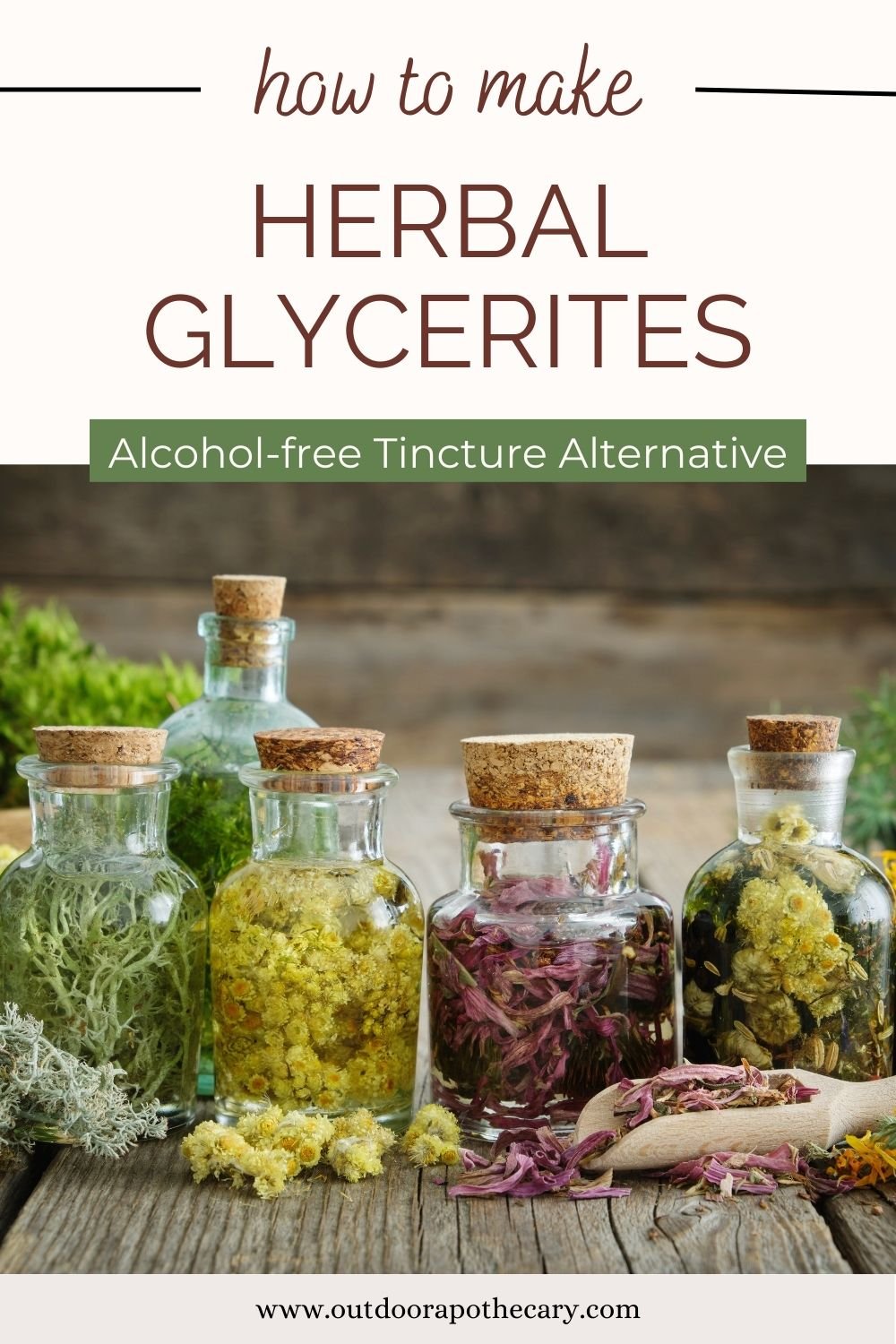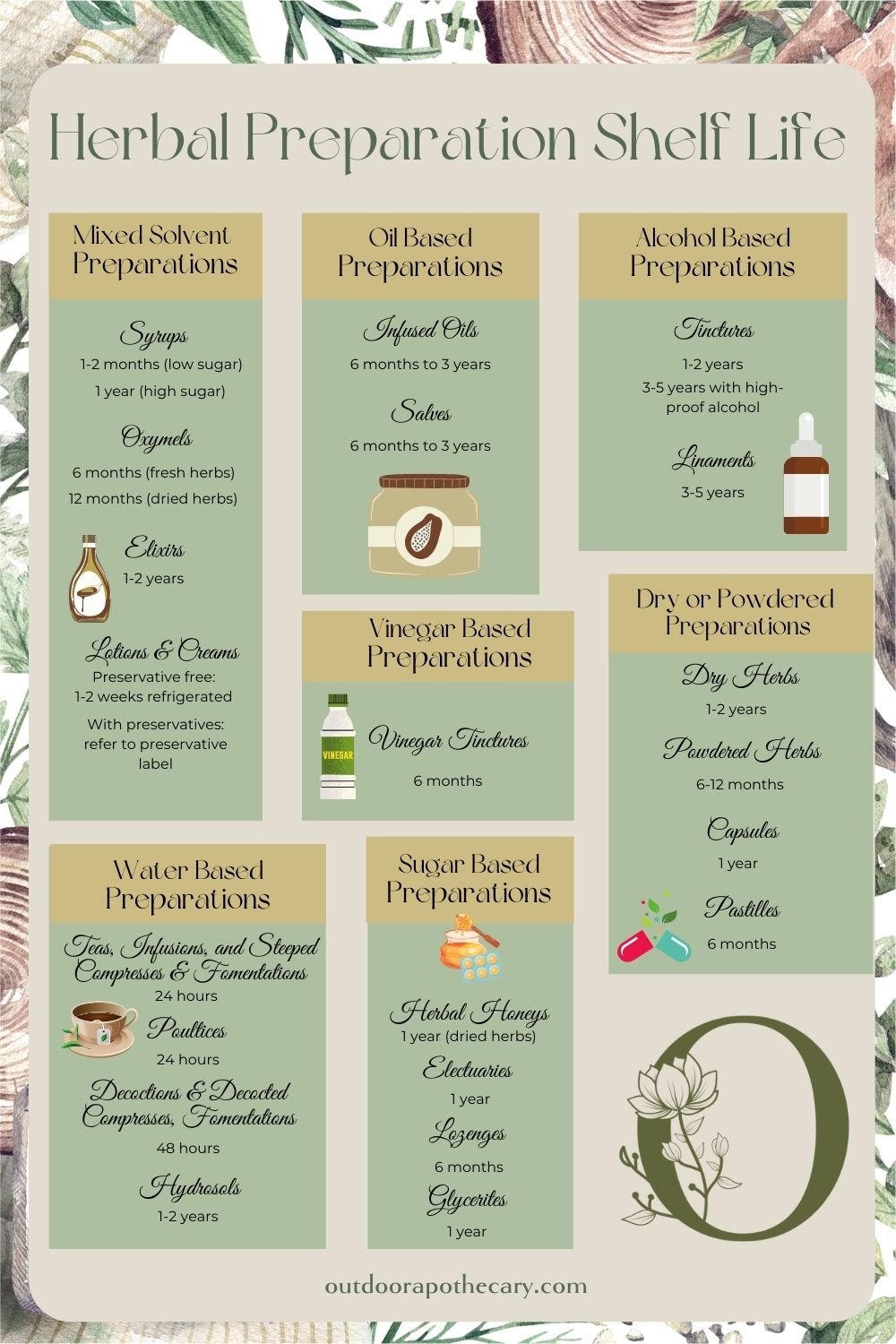Oh, how I love the wonders of nature and the healing powers of herbs! Have you heard of herbal glycerites? I love them! Unlike traditional tinctures, glycerites use vegetable glycerin as a solvent, making them perfect for children and anyone who prefers to steer clear of alcohol.
Not only are glycerites gentle and effective, but they also allow us to enjoy the medicinal benefits of herbs year-round. What’s even better is that making herbal glycerites is a super easy! With just a few simple pieces of equipment and your choice of fresh plant material or dried herbs, you can whip up a batch of glycerite in no time. It’s almost identical to making tinctures, but without the alcohol content.
Just imagine having a whole herbal medicine cabinet filled with homemade glycerites for every use and occasion! The possibilities are endless. Trust me, once you start making herbal glycerites, you’ll never want to go back to store-bought remedies.

What is a Herbal glycerite?
Herbal glycerites are a type of herbal extract that are made using vegetable glycerin as the solvent instead of alcohol. Glycerites are an excellent alternative for individuals who wish to avoid alcohol or who are sensitive to its effects.
Vegetable glycerin is a clear, sweet, and viscous liquid that is derived from plant oils such as coconut or soybean. It is a natural humectant, which means it attracts and retains moisture, making it an ideal ingredient in skincare and cosmetic products. Vegetable glycerin is also used in the food industry as a sweetener, preservative, and thickener.
To make vegetable glycerin, plant oils are heated under pressure with water and an alkaline catalyst, such as lye. The mixture is then distilled, resulting in a clear liquid that is approximately 99.7% pure vegetable glycerin.
When making a herbal glycerite, the plant material is soaked in a mixture of vegetable glycerin and water for several weeks, allowing the glycerin to extract the active compounds from the herbs. The resulting liquid is then strained and bottled for use as a herbal remedy.
One of the benefits of herbal glycerites is that they are sweet and palatable, making them an excellent choice for children or anyone who dislikes the taste of alcohol-based tinctures. And while herbal glycerites aren’t as potent as alcohol-based tinctures, they still deliver potent herbal benefits.
In summary, herbal glycerites are a gentle and effective way to extract the medicinal properties of herbs using vegetable glycerin as the solvent. They offer a sweet and palatable alternative to alcohol-based tinctures and are an excellent addition to any herbal medicine cabinet.

Making a Herbal Glycerite with Fresh or Dried Herbs
Making a herbal glycerite is a simple and rewarding process that can be done with either fresh or dried herbs. Here are the basic steps for making a glycerite using each method:
Materials:
- Fresh or dried plant material, roughly chopped
- Pure vegetable glycerin
Equipment & Tools:
- A mason jar with a tight-fitting lid.
- Funnel
- Cheesecloth
- Measuring cup or bowl
- Dark amber dropper bottles
- Jar Labels
Method 1: Using Fresh Herbs
- Begin by gathering your fresh herbs. Make sure they are clean and free of debris.
- Roughly chop or crush the herbs to release their essential oils.
- Fill a jar 3/4 of the way full of the chopped herbs.
- For fresh herbs, you can use 100% vegetable glycerine
- Pour the glycerin solution over the herbs, making sure they are completely covered.
- Use a spoon or knife to release any air bubbles and ensure that the herbs are fully saturated.
- Cap the jar tightly and place it in a cool, dark place for 4-6 weeks, shaking it every few days to mix the ingredients. Add more glycerin to the jar if any plant matter becomes exposed.
- After 4-6 weeks, strain the liquid through a few layers of cheesecloth or a fine mesh strainer into a clean bottle. Label the bottle and store in a cool, dark place.
Method 2: Using Dried Herbs
- Begin by gathering your dried herbs. Make sure they are clean and free of debris.
- Fill a jar about 1/2 way with the dried herbs. They will expand as they sit in the liquid.
- Mix together a solution of 75% vegetable glycerin and 25% water. If necessary, you can reduce the amount of glycerine in your herbal glycerite to around 60%. However, it’s important not to use less than 60% glycerine, as this could lead to spoilage of your glycerite.
- Pour the glycerin solution over the herbs, making sure they are completely covered.
- Use a spoon or knife to release any air bubbles and ensure that the herbs are fully saturated.
- Cap the jar tightly and place it in a cool, dark place for 4-6 weeks, shaking it every few days to mix the ingredients. Add more glycerin to the jar if any plant matter becomes exposed.
- After 4-6 weeks, strain the liquid through cheesecloth or a fine mesh strainer into a clean bottle. Label the bottle and store in a cool, dark place.
Note: When making a glycerite, the ratio of water to glycerin is significant. Generally, a ratio of 75% glycerin to 25% water is used. This ratio ensures that the glycerin is thick enough to extract the active compounds from the herbs while still being fluid enough to allow the mixture to penetrate the plant material.

The Shelf Life of Herbal Glycerites
The shelf life of herbal glycerites can vary depending on the type of herb used, the preparation method, and storage conditions. However, in general, herbal glycerites have a shelf life of approximately one to two years when stored properly.
Proper storage of herbal glycerites includes keeping them in a cool, dark place away from direct sunlight and heat. It’s also important to make sure the bottle or jar is tightly sealed to prevent oxidation and moisture from entering.
Compared to alcohol tinctures, herbal glycerites tend to have a shorter shelf life. Alcohol tinctures, which use high-proof alcohol as a solvent, can last for several years when stored properly. However, alcohol tinctures may not be suitable for everyone due to the high alcohol content, which can be problematic for those who are sensitive to alcohol or who are in recovery from addiction.
Herbal glycerites, on the other hand, provide a gentler and alcohol-free alternative. While they may have a shorter shelf life compared to alcohol tinctures, they are still an effective and convenient way to use herbs for a variety of purposes, including soothing anxiety, promoting sleep, and supporting overall wellness.
To ensure the longest possible shelf life for your herbal glycerites, it’s important to follow proper preparation and storage methods, including using high-quality herbs, mixing them with the appropriate ratio of glycerin and water, and storing the finished product in a cool, dark place away from direct sunlight and heat.

Where to buy herbs
If you don’t have access to local or homegrown herbs, I highly recommend purchasing them from Mountain Rose Herbs. They are my favorite place to buy high-quality, organic dried herbs and herbal products. As a company they believe in people, plants, and planet over profit and only ever source their herbs ethically and sustainably. It is through this ethical, responsible sourcing, that they are able to offer one of the largest selections of certified organic herbs, spices, and botanicals in North America.
Where to take courses in herbalism
I want to share my love for herbalism and encourage a broader interest in the healing power of plants, but I want to make it clear that I am not qualified to offer medical advice. Please use the information I provide as a starting point for your own research, and always verify anything you read with multiple sources.
It’s important to remember that every person’s body is unique, and what works for one person may not work for another. Even gentle herbs like chamomile can cause adverse reactions in some people. Before trying any new medicinal plant, please consult with a doctor or certified herbalist, especially if you are taking other herbs or supplements.
If you are serious about learning more about herbal medicine, I highly recommend investing in a course from the Herbal Academy of New England. Their online courses, such as the Introduction to Herbal Medicine course and the Family Herbalist group of courses, are informative, inspiring, and artfully presented. They also offer courses on mushroom identification and botany & wildcrafting, which can deepen your knowledge of plant identification and help you safely and responsibly forage for medicinal plants in the wild.

Other Remedies You Can Make Yourself
Do you want to stock your medicine with other herbal remedies? Here are a few easy remedies you can make yourself.
Disclaimer- I am not a medical professional. All information shared here is for information and entertainment only. Do your own research and consult your health care provider before treating yourself with any product, plant or mixture.
As an Amazon Associate, I earn from qualifying purchases.


